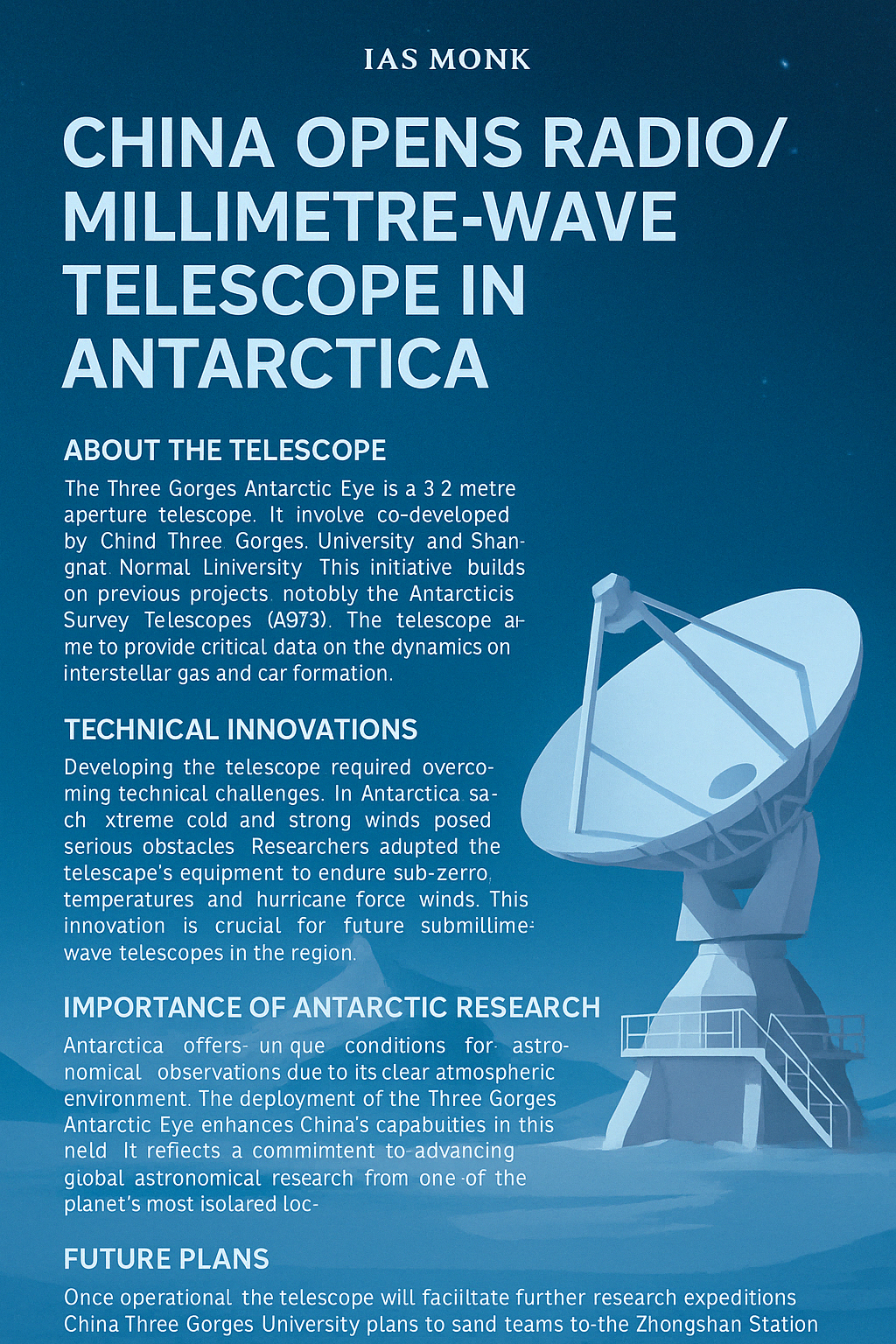
003 – Apr 9, 2025 🛰️
The Antarctic Eye Opens: China’s New Radio Telescope Peers into Star birth Mysteries

🧭 Thematic Focus
Category: Space Science | Global Scientific Collaboration | Technology and Innovation
GS Paper: GS Paper III – Science & Technology | International Research
Tagline: Where cold wind howls, the stars begin to speak.
🔍 Key Highlights
🧬 What Is the “Three Gorges Antarctic Eye”?
- A 3.2-metre aperture radio/millimetre-wave telescope
- Inaugurated at Zhongshan Station, Antarctica
- Jointly developed by China Three Gorges University & Shanghai Normal University
- Follows earlier telescopic innovations like AST3 (Antarctic Survey Telescopes)
🌌 Scientific Objectives
- Study interstellar gas, especially:
- Neutral hydrogen (21 cm line)
- Ammonia (NH₃) emissions
- Understand star formation processes in Milky Way
- Build models of gas dynamics, molecular cloud evolution, and early stellar nurseries
❄️ Why Antarctica?
- Pristine atmospheric conditions
- Extremely low humidity, minimal light pollution
- Excellent for submillimeter and millimetre wave astronomy
- Challenges: -60°C temps, hurricane-force winds, logistical isolation
⚙️ Technical Innovations
- Special thermal insulation systems for mirror stability
- Custom wind shielding, automated alignment tech
- Built to endure Antarctica’s punishing climate
🔭 Broader Global Context – Similar Observatories
| Observatory | Country | Focus Area |
|---|---|---|
| INO | India | Solar & atmospheric neutrinos |
| IceCube | USA (Antarctica) | Cosmic neutrinos |
| JUNO | China (2025) | Neutrinos from Earth & Sun |
| DUNE | USA (2030) | Neutrino oscillations & supernovae |
| TRIDENT | China (South China Sea) | Deep-sea neutrino detection |
🌌 Future Plans
- Regular scientific expeditions to Zhongshan Station
- Data to feed into China’s star formation models
- Academic research-led science diplomacy
- Long-term aim: Antarctica as a global astronomy frontier
🧠 Concept Explainer: Why This Matters
Radio silence is rare. Antarctica offers it in abundance.
By launching a telescope at Earth’s coldest edge, China listens to galactic birth from beneath the stars—quiet, ancient, and undisturbed.
🗺️ GS Paper Mapping
- GS Paper III – Scientific Missions, Space Research, Climate-Adaptive Technology
- GS Paper II – International Cooperation in Research
- Essay Themes – “Eyes Where No One Looks,” “Cold Science, Cosmic Truths”
💭 A Thought Spark — by IAS Monk
“Beneath a white silence,
a metal eye awakens
not to see the stars—
but to hear
how they are born.”


















